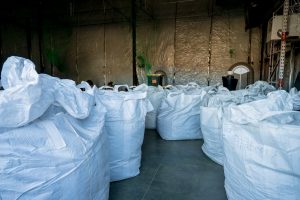
(Photo courtesy of Hemptown)
(This is an abridged version of a story that appears in the July issue of Marijuana Business Magazine.)
Traditionally, industrial hemp has two main commercial uses: food and fiber.
The two uses have distinctly different storage needs:
Food: Hemp grain storage is often kept on-farm. Canada requires hemp grain to be stored in clean, dry, aerated and locked bins. These can be similar to the steel bins used for corn, wheat and other crops. But unlike those grains, which are often heavily processed, hemp is served as a raw food, according to Russ Crawford, president of the Canadian Hemp Trade Alliance.
Trey Riddle, CEO of Sunstrand, a Kentucky-based natural fiber manufacturer, said he receives field-retted hemp straw in plastic-wrapped round bales from his contracted growers.
“It has to be baled dry, at a low moisture content like 12%, so it does not mold in storage,” he said.
To read more about fiber and grain storage strategies, click here.

